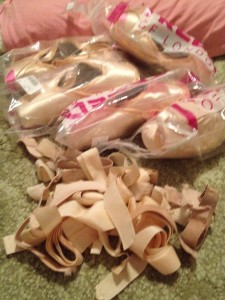Throughout the month we’ll be hearing a variety of things about pointe shoes–from what they do to the feet, to how they are made. Today we have Emily Kate Long with us to talk about how she breaks in her pointe shoes…

I wear Freed Classic Pro, “Anchor” maker. Since I’m unable to get special order shoes, I do a lot to mine to make them just right.
First things first: ribbons and crisscross elastic go on. I sew the heel ends of the elastics slightly towards the outside of the heel seam so the shoe won’t twist in and sickle. Then the back nail comes out, I bend the shanks and step on each shoe, and they are ready to break in with some releves.
Once the box is a little more pliable, I take a cotton drawstring (stockpiled from when I wore Chacott or borrowed from other dancers; Classic Pro have elastic drawstrings) and twist it into a little rope to sew around the platform of each shoe. I use the wear pattern on the satin to inform the placement of the darning–usually I make it so the stitching pushes me a little farther over the shoe and a little to the inside.
Darning also helps correct any lumps or imperfections on the pleats or platform and quiets the shoes down. I also sew the sides of the shoes down so my foot doesn’t look like it has a turtleneck sweater on. I think pointe shoes should look like a beautiful evening gown, complete with plunging neckline!
Step three: noise control! Loud shoes are my worst nightmare, so I mush up the box more and do lots of changements before I glue them. Then a light coating of glue on the inside, mainly on the pleats and along the shank. Once the glue cures they are ready to go. I usually keep three or four pairs ready: harder for class and classical rehearsals, softer for contemporary work, and one really dead comfy pair for rehearsals that involve a lot of standing around.
About the dancer:
Emily Kate Long began her dance education in South Bend, Indiana, with Kimmary Williams and Jacob Rice and graduated in 2007 from Pittsburgh Ballet Theatre School’s Schenley Program. Ms Long attended Milwaukee Ballet School’s Summer Intensive on scholarship before being invited to join Milwaukee Ballet II in 2007. She also has spent summers studying at Saratoga Summer Dance Intensive, Miami City Ballet, Pittsburgh Ballet Theatre School, Pittsburgh Youth Ballet, and Ballet Chicago.
Ms Long has been a member of Ballet Quad Cities since 2009. She has danced featured roles in Deanna Carter’s Ash to Glass and Dracula, participated in the company’s 2010 tour to New York City, and most recently performed the title role in Courtney Lyon’s Cinderella and the role of Clara in The Nutcracker. Prior to joining Ballet Quad Cities Ms Long performed with Milwaukee Ballet and MBII in Michael Pink’s The Nutcracker and Candide Overture, Petipa’s The Sleeping Beauty and La Bayadére, Balanchine’s Who Cares?, Bournonville’s Flower Festival in Genzano and Napoli, and original contemporary and neoclassical works by Tom Teague, Denis Malinkine, Rolando Yanes, and Petr Zaharadnicek. She also collaborated extensively with the Milwaukee Ballet Education Department on the children’s ballet Maria and the Magic Doll Shoppe, which toured to over 20 venues throughout southeastern Wisconsin.
Shop Indie Bookstores






Hi! Great post 🙂
Could you please share how exactly you sew the drawstring around the platform? I could really use that myself! Especially if you could explain how to sew it like you said, so that it pushes you a little more over and to the inside – I tend to have a problem with my shoes twisting outward and ‘sickling’ slightly, and I think this could help a lot!!
Thanks!
Noa
I have the same comment as noa, I thought the darning was for dancers who go over the box too far, so, I’ve never done it, however, if there is a way to encourage me to go farther, I would love to know. Also, what do you mean about the sides looking like a turtleneck? Do you actually shorten the sides through sewing? thanks!